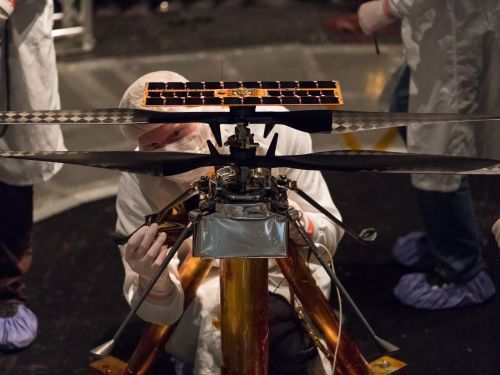
NASA has a bold plan to send not only a rover but also a helicopter to Mars as part of its Mars 2020 mission. The autonomous Mars Helicopter, which NASA hopes will be the first aircraft to fly on another planet, successfully passed its flight tests and vacuum and deployment tests. Now, the helicopter has been attached to the Mars 2020 rover ready for its journey to the red planet.
The rover was secured onto a plate on the rover’s belly and covered by a shield to protect the delicate machine from rocks and other debris which will be kicked up during entry and landing on Mars. Once the craft has landed safely, the helicopter will emerge from behind its shield and be sent into the sky to explore the Jezero Crater region around the landing zone.
As the helicopter is a highly experimental piece of equipment, the engineers won’t be relying on it to collect any important scientific data. Instead, the Mars mission will act as a real-world test for the reliability of the helicopter, so NASA can see if it can move around the planet despite the thin atmosphere. If it’s successful, engineers can use what they learn to create next-generation helicopters for future missions.
“Our job is to prove that autonomous, controlled flight can be executed in the extremely thin Martian atmosphere,” MiMi Aung, the Mars Helicopter project manager at NASA’s Jet Propulsion Laboratory, said in a statement. “Since our helicopter is designed as a flight test of experimental technology, it carries no science instruments. But if we prove powered flight on Mars can work, we look forward to the day when Mars helicopters can play an important role in future explorations of the Red Planet.”
The primary advantage of having a helicopter as well as a rover is that an airborne craft can explore locations that would be impossible to reach from the ground. This includes maneuvering around geographical features like cliffs, chasms, and caves to get a more detailed view of the Martian environment. In the future, helicopters could also carry scientific equipment to gather data from distant locations, or they could be used as scouts for investigating a region ahead of human or robot explorers.
For now, we’ll have to wait and see how the first helicopter for an extraterrestrial environment fares on its inaugural mission. The launch of the Mars 2020 mission is scheduled for July next year.
Editors' Recommendations
- NASA’s Mars rover uses its self-driving smarts to navigate toughest route
- NASA’s Mars drone captures cool shots of rover landing gear
- NASA marks a year since Mars drone’s historic first flight
- Watch how the Perseverance rover drives autonomously across Mars
- NASA’s Mars helicopter will fly furthest yet in next flight